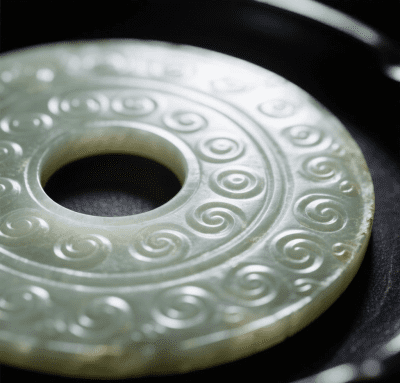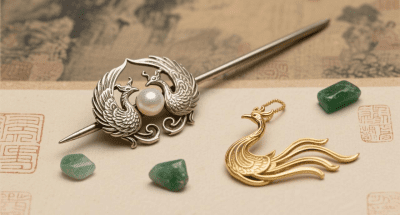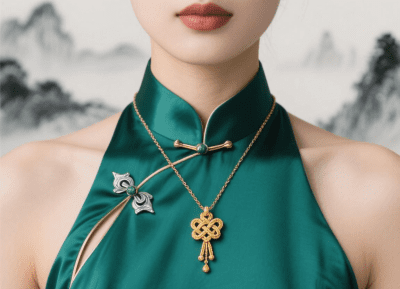The Silent Harmony in Every Fold: Why Symmetry is China’s Ancient Love Language
An extreme close-up of a pale celadon jade disc. Perfectly mirrored, comma-shaped gǔwén (“archaic pattern”) concentric curves radiate from a central aperture. Raking sidelight casts microscopic shadows, revealing how each relative curve echoes its neighbor with Neolithic precision.
Background: Matte black lacquered board.
Focus: The hypnotic rhythm of ancient symmetry—not the flawlessness of machines, but an organic repetition that resonates with rice paddies or water ripples.
You glance in a mirror. Your face is (roughly) symmetrical. Nature favors this balance—from butterfly wings to snowflakes. But in China 5,000 years ago, symmetry went beyond biology; it became sacred geometry connecting heaven and earth. Unlike the Greek pursuit of mathematical perfection, Chinese symmetry embraced living balance—think of paired phoenixes whose tail feathers differ slightly, or dragon claws that mirror but never duplicate each other. This philosophy pulses through every ornamental design:
-
Bronze Age Ritual Vessels:
Shang dynasty wine cups wear taotie masks—ferocious faces split down the center, each side a mirrored (but not identical) beast. Why? Symmetry wasn’t decoration; it held cosmic power, trapping chaotic spirits in balanced forms. -
Imperial Dragon Robes:
Qing emperors wore robes embroidered with duìlóng—paired dragons coiling symmetrically around a pearl. Their bodies mirrored each other, yet the claws and whiskers danced in unique gestures—symbolizing imperial order with room for dynamic action. -
Ming Hairpins:
Jade zan pins often end in a butterfly pair. The wings reflect each other, but the vein patterns subtly differ—a celebration of marital harmony through “unity that is not uniform.”
A conversation across centuries.
Left: A Qing dynasty silver hairpin, where two phoenixes rise symmetrically from a central pearl, their feathers rendered in delicate filigree.
Right: A contemporary 18k gold pendant—one phoenix fully formed, the other deconstructed into abstract curves.
Between them: Scattered raw jade beads symbolize continuity.
Background: Handmade paper with faint ink-brushed mountain silhouettes.
Lighting: Cool daylight highlights the craftsmanship’s evolution—from rigid symmetry to fluid allusion.
Why the obsession with mirrored forms?
Duìchèn (symmetry) has never been merely “pretty” in Chinese culture. It encodes a foundational worldview:
-
Cosmic Order:
The yin-yang symbol is symmetry in motion—balanced opposites generating harmony. Wearing symmetrical jewelry aligns you with Taoist rhythms of the universe. -
Social Harmony:
Confucianism values shù (mutuality). Just as jewelry’s left side reflects its right, relationships thrive on reciprocal respect—between ruler and subject, husband and wife. -
Protection:
Evil spirits were believed to crave chaos. Symmetrical amulets, like twin fish pendants, created “energy mirrors” to deflect misfortune.
The Genius of ‘Broken’ Symmetry
True mastery lies in controlled imbalance. Consider these subtle acts of rebellion:
-
Han Dynasty Belt Hook:
Jade dragons coil in symmetry—except one claw grips the pearl just a bit tighter, injecting narrative tension. -
Song Dynasty Earrings:
Twin golden mandarin ducks face each other; one holds a lotus bud, the other a full bloom—symbolizing love’s journey from beginning to fulfillment. -
Hidden Messages:
A Ming bracelet may seem perfectly mirrored—until you notice: the left dragon has five claws (imperial), while the right has four—a veiled protest against the emperor.
Modern elegance meets tradition. A deep emerald-green silk qipao with a standing collar gently contours the shoulder. The Harmony Knot pendant rests slightly left of center—its front reveals a symmetrical knot in polished gold, while its visible back reveals a deliberately “flawed” knot in oxidized silver.
Lighting: Soft studio light makes the gold glow against the silk backdrop.
Background: Blurred calligraphy scroll.
Focus: A wearable meditation on the dialogue between perfect façade and imperfect truth.
Wisdom in Adornment: The Harmony Knot Pendant
This piece embodies millennia of balancing acts:
-
Golden Face:
A hand-woven 18k gold knot forms a flawless symmetrical mandala—symbolizing outward harmony and graceful social presence. -
Silver Underside:
A broken, oxidized silver knot rests hidden against the skin—an homage to asymmetry in life, and the beauty found in personal imperfections.
-
The Pearl: A single Akoya pearl suspended at the base – the perfect sphere balancing between order and chaos.
Why Let This Balance Resonate?
-
A Daily Reminder: Touch the cool silver back when perfectionism bites. Feel the warm gold front before important meetings. Your jewelry becomes a tactile meditation.
-
Spark Cultural Curiosity: “Why two sides?” becomes a gateway to discussing Taoism’s dance of opposites or Confucian reciprocity – no politics, pure poetry.
-
Timeless Versatility: Layer it with a band tee or wear solo with silk. Its message transcends trends: balance isn’t rigidity – it’s dynamic grace.
“My Harmony Knot isn’t about being perfect. The ‘messy’ back reminds me that my anxiety and creativity come from the same place – and that’s okay.”
**– Maya, Brooklyn**



I bought the Harmony Knot pendant after reading this blog—and it’s transformed how I see “perfection.” At first glance, the front’s symmetrical gold knot mesmerized my design team (“How is this hand-woven?!”), but the real magic lives on the oxidized silver back. Its “flawed” knot isn’t messy; it’s human. During a pitch meeting, rubbing that textured silver underside grounded me like a worry stone. My colleague noticed and joked, “Is that your secret confidence hack?”
The blog’s historical context gave me chills. Knowing Shang bronze-casters used asymmetry to trap chaos (while Qing dragons danced with imperfect claws) makes wearing this feel like curating a museum exhibit. I’ve worn it with everything—a silk blazer for investor talks (gold face shining like “social armor”), and a band tee on weekends (silver back peeking out as my “authenticity badge”).
That single Akoya pearl? Genius. It rolls between order and chaos with every step, catching light differently at 9 AM (crisp gold geometry) versus 9 PM (moonlit silver shadows). My therapist loves it: “A tangible reminder that growth lives in the unbalanced places.”
Forget “pretty jewelry.” This is wearable philosophy. As the blog says: true balance breathes.